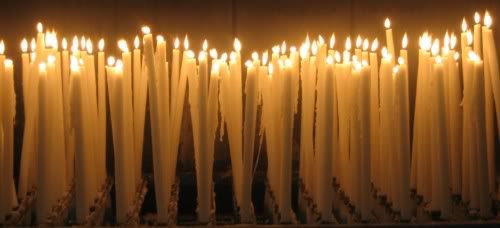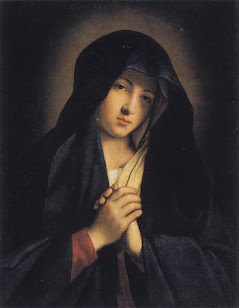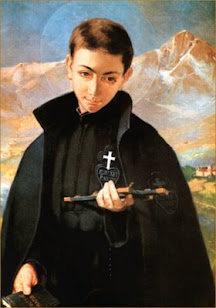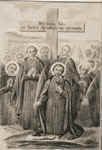May 29 marks the feast day of two groups of martyrs for the Catholic faith: Saint William Arnaud and the Martyrs of Toulouse and Saint Theodosia of Constantinople and companions. Both groups, at very different times, in very different places, died aggressively defending their faith, proclaiming the Good News of Christ.
Saint William Arnaud (died 1242) and eleven companions dies in Avignonet, France, and are known as the “Martyrs of Toulouse.” William, a Dominican friar, was sent with his companions by Pope Gregory IX, appointed inquisitors, to the regions of France to combat heresy which was spreading under the guise of Albigensianism (a theory of dualism which considered the body evil, thereby preventing resurrection. Christ was thought to have not been man, given that he would have succumbed to evil, had he been. This theory removed the Sacraments of the Church, replacing them with pagan rituals for purification).
Along with William, were Bernard of Roquefort and Garcia d’Aure of Comminges, both Dominicans. Two Franciscan friars accompanied them, Stephen Saint-Thibery and Raymond Cortisan. A Benedictine friar, Raymond Cortison, referred to as “the Writer” originally from Toulouse, joined them, as did Bernard from the cathedral of Toulouse. Pietro d’Arnaud, notary of the Inquisitors, and Fortanerio and Adhemar, clerics of the Inquisitors, completed the group of martyrs.
This group of brave men found most every door to them closed in Toulouse, under penalty of punishment from the ruling count at the time. They set up a small farmhouse outside the city gates, preaching throughout the countryside with great success. Many were converted, and many miracles of healing were performed. Eventually, their presence became threatening to the local government, who lured the holy men to an ambush by spreading word that the ruling Count—an acquaintance of Saint William—was ready to reject his heretical beliefs and return to the Church.
On the eve of the Ascension of Our Lord, the martyrs, having received a heavenly vision of their imminent martyrdom, traveled as a group to the castle of Count Raymond III of Toulouse, where his soldiers fell upon them in the great hall, slaughtering 7 of the 11. The remaining four—including William—escaped to a local Church, where they were found by the soldiers singing the Te Deum. It was here, in the church, that they were murdered—an act unforgivable in Medieval times due to the principle of sanctuary. Particularly angered by the singing, the soldiers first cut out Saint William’s tongue, prior to killing him. The bodies of the martyrs were thrown down a ravine and large boulders were rolled on top of them. As evening fell, however, bright, heavenly lights streamed from their bodies, leading the faithful to them to collect their relics. They were interred in the Church of San Romano at the monastery in Toulouse.
The church of Avignonet where they were murdered was placed under interdict, the doors closed and locked, because of the sacrilege, and for 40 years no Mass was celebrated there. When the interdict was lifted, the bells rang of themselves, according to legend, to let people know that Avignonet was once more a member of the living Church.
Saint Theodosia (died 729) and her companions were nuns in Constantinople who were martyred for their defense of the Church. Born into a noble family in Turkey, she was orphaned at an early age and was raised and educated at the monastery of Saint Anastasia. During her lifetime, Saint Theodosia committed herself to prayer and service to those in need.
During this time, the Church was divided over the bodily depictions of Christ in the form of icons. Emperor Leo III the Isaurian ordered the iconoclast persecutions—that is, the removal and destruction of such artistic renderings. Countless icons were destroyed during this period and those who defended them oftentimes became martyrs for their faith. The position of the icon defenders was one of love for the Lord, and pure worship, captured by Saint John of Damascus: “In former times God, who is without form or body, could never be depicted. But now when God is seen in the flesh conversing with men, I make an image of the God whom I see. I do not worship matter; I worship the creator of matter who became matter for my sake . . .”
One such martyr in defense of this historical iconic record of the Church in depicting Our Living God was Saint Theodosia. When the soldiers of Emperor Leo III were ordered to remove the image of Christ which stood over the Chalke Gate of the Imperial Palace, Saint Theodosia and 12 companion nuns attempted to prevent the destruction, crying out, and preaching the faith. Saint Theodosia herself is said to have shook the ladder so violently that the soldier climbing to destroy the icon was knocked from it, and eventually died. She, and her companions, were arrested and tortured for their interference with the emperor’s orders. While her companions were decapitated, Saint Theodosia was designated the leader and sentenced to a more painful and slow death. She was eventually killed by having a ram’s horn plunged deep into her neck, slowing exsanguinating.
Following the restoration of the icons, eighty years after her death, Theodosia’s remains were placed in a Constantinople convent, where they are venerated by procession. Numerous healings have been recorded via her intercession.
Both the Martyrs of Toulouse and the Martyrs of Constantinople died defending their faith. Out of obedience to the Lord, they willingly went to their deaths, when through passivity they could have most certainly been avoided. We are reminded of the fire burning within each of us—the flames of the Holy Spirit descended at Pentecost—and are inspired of the good we can do in the world should we let out lives become mirrors of Christ!
Year 2: Day 149 of 365
Prayer Intentions: Courageous living of our faith!
Requested Intentions: For health of friend, for successful relationships for children, for safe pregnancy for daughter (C); For the health of a mother (J); Virtue for daughter (V); Successful acceptance to college for nephew (M); For the health of a cousin (T); Freedom from legal difficulties for husband (S); Husband’s freedom from illness (L); Personal intentions (S); Successful passing of dental board examination (P); Blessings on a family (Z); Successful permanent employment (C); Healing of a son with autism (J); Son’s successful employment (L); For the intentions of family and relatives, for the Carthusian community (T); For personal intentions (A); Restoration of lost hearing (C); Resolution of relational and financial challenges (S); Comfort following loss of husband, security for family, assistance with housing (B); Healing and return of brother (O); Successful hermitage foundation (S); Support from family, permission to marry (H); Recovery of wife following surgery, freedom from depression (W); Protection and recovery of mentally ill daughter (J); Successful resolution to legal proceedings (N); Freedom from worry and successful employment (M); For successful sale of home and freedom from debt (J); Freedom from pain and illness (E).
Why pray the Rosary every day for a year?
Each time the Blessed Virgin has appeared-- whether it be to Saint Bernadette Soubirous at Lourdes; to Lucia, Jacinta, and Francisco at Fatima; or to Mariette Beco at Banneux-- she has asserted the importance, saving grace, and power of praying the Holy Rosary on a daily basis. Based upon her words, the Rosary is penance and conversion for sinners, a pathway to peace, an end to war, and a powerful act of faith in Jesus Christ. Pope Paul VI presented the Rosary as a powerful means to reach Christ "not merely with Mary but indeed, insofar as this is possible to us, in the same way as Mary, who is certainly the one who thought about Him more than anyone else has ever done."
To show us how this is done, perhaps no one has been more eloquent than the great Cardinal Newman, who wrote: "The great power of the Rosary consists in the fact that it translates the Creed into Prayer. Of course, the Creed is already in a certain sense a prayer and a great act of homage towards God, but the Rosary brings us to meditate again on the great truth of His life and death, and brings this truth close to our hearts. Even Christians, although they know God, usually fear rather than love Him. The strength of the Rosary lies in the particular manner in which it considers these mysteries, since all our thinking about Christ is intertwined with the thought of His Mother, in the relations between Mother and Son; the Holy Family is presented to us, the home in which God lived His infinite love."
As Mary said at Fatima, "Jesus wants to use you to make Me known and loved. He wishes to establish the devotion to My Immaculate Heart throughout the world. I promise salvation to whoever embraces it; these souls will be dear to God, like flowers put by Me to adorn his throne."

Subscribe to:
Post Comments (Atom)













0 comments:
Post a Comment
Thanks for leaving a comment. If you wish to submit a prayer request, however, please do so above, using the "Contact" tab.